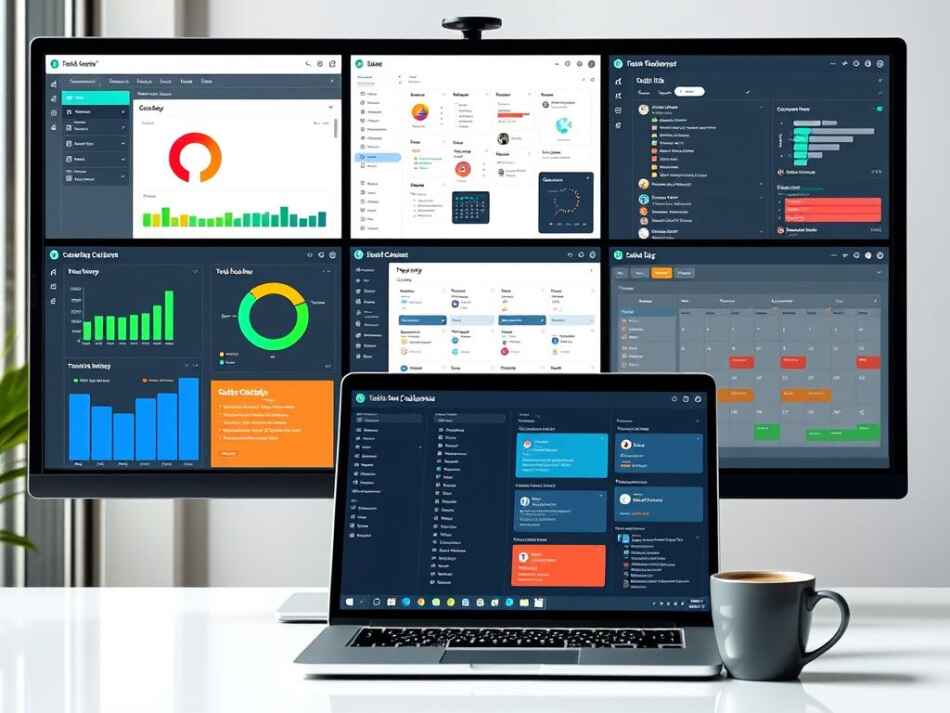I remember when I first needed help with my work. My desk was covered in sticky notes, and my calendar was a mess. I felt overwhelmed.
That’s when I found task management tools. They changed my work life from chaotic to smooth. They helped me work faster and reach my goals sooner than I thought.
Task management and productivity apps are key in today’s fast work world. With more people working from home, these tools are now a must. They help keep projects organized and teams on track.
The Project Management Institute’s 2024 report shows a key point. Project managers need to know how to use AI to manage projects well. This shows how important it is to learn about task management tools in our digital work world.
These tools range from simple to-do lists to complex project systems. They offer features like scheduling, customization, and tracking progress. Apps like Asana, Trello, and Monday.com have changed how teams work together and track their progress.
In this article, we’ll look at how task management tools can change your work. They can make you more productive and help teams work better together. Whether you work alone or with a big team, there’s a tool out there to help you work smarter.
Understanding Workflow Management Fundamentals
Workflow management is key to making business operations smoother. It organizes and automates tasks for a seamless process from start to end.
Defining Workflow Management
Workflow management is about coordinating tasks, info, and resources for business goals. It makes processes efficient and cuts down errors. The global market for workflow management was $6.85 billion in 2020. It’s expected to grow by 30.6% from 2021 to 2028.
Benefits of Automated Workflows
Automation in workflow management brings many benefits. It reduces manual errors, boosts productivity, and improves teamwork. McKinsey found workers spend nearly 20% of their week searching for info or help. Automated workflows can greatly cut down this time.
Key Components of Effective Workflow Systems
Good workflow systems have key parts like inputs, tasks, sequence, and outputs. They connect people, processes, and tasks for efficient operations. This includes different workflow types like sequential, parallel, and conditional.
| Workflow Type | Description | Example |
|---|---|---|
| Sequential | Tasks follow a set order | Order processing for online purchases |
| Parallel | Multiple tasks occur simultaneously | Project proposal submission and approval |
| Conditional | Tasks depend on specific conditions | Customer support issue resolution |
Task Management Tools and Their Impact on Productivity
I’ve seen how task management tools change the game in the workplace. They make workflows smoother, projects more efficient, and tasks easier to manage. Let’s look at the numbers that show their power.
Many workers, 41%, feel stressed because of too much work. Task management tools help by making things clear and organized. For example, ClickUp offers 15+ project views. This lets teams organize tasks in a way that works best for them, making work better.
These tools really make a difference. Without them, 70% of workers waste up to 20 hours a week looking for stuff. Task management software makes this time disappear, making work more efficient. It also helps with time management by tracking how long tasks take and how teams are doing.
| Productivity Aspect | Impact of Task Management Tools |
|---|---|
| Time Savings | Reduces 20 hours/week spent on information search |
| Workload Management | Alleviates stress for 41% of workers |
| Project Visibility | Provides 15+ project views for comprehensive oversight |
| Task Handling | Manages 100+ active tasks across departments daily |
Project efficiency goes up with features like tracking progress in real time and automatic tasks. These tools take away the boring stuff that used to slow down project managers. By making task assignment, teamwork, and reports easier, teams can do more important work. This boosts productivity to new levels.
Popular Task Management Platforms for Teams
I’ve looked at many project management software and team collaboration tools. I wanted to find the best for making work easier. Let’s look at some popular ones that can help your team work better.
Asana for Project Organization
Asana is a top choice for managing projects. It makes creating tasks and tracking progress easy. You can assign tasks and see how everyone is doing.
Trello’s Visual Approach
Trello uses boards to manage tasks in a visual way. It’s perfect for teams that like seeing their work laid out.
Monday.com’s Customizable Solutions
Monday.com is flexible and fits your needs. It has features for automating tasks. It’s great for teams wanting a custom experience.
Jira for Agile Teams
Jira is great for agile teams. It has tools for planning and tracking work. It’s best for teams doing software development.
| Platform | Key Feature | Best For |
|---|---|---|
| Asana | Visual timelines | Project organization |
| Trello | Kanban boards | Visual task management |
| Monday.com | Customization | Flexible workflows |
| Jira | Agile tools | Software development teams |

Choosing the right platform depends on your team’s needs. Think about the project’s complexity, team size, and how you like to work. This will help you pick the best software.
Essential Features of Modern Workflow Tools
I’ve seen a lot of workflow management tools lately. There are hundreds out there, all promising to make work easier. Let’s look at the main features that make these tools great for teamwork and tracking tasks.
Task Assignment and Tracking
Today’s workflow tools are top-notch at managing tasks. They can automatically assign tasks to people or teams. They also set due dates based on what comes first, so things get done on time.
This helps keep projects running smoothly and meet deadlines. It’s all about keeping things on track.
Collaboration Capabilities
Teamwork is at the core of these tools. They have built-in ways to talk about tasks and processes. They also have forms and tables for sharing information easily.
This makes work better and faster. It helps avoid delays and improves quality.
Integration Options
The best tools work well with other apps. This makes work easier and more efficient. You can connect everything from project management to accounting.
This reduces the need to enter data by hand. It makes work smoother and more productive.
Reporting and Analytics
These tools also offer detailed reports and analytics. They show how well things are going and help make smart choices. They can send reports automatically, so you always know how things are doing.
| Feature | Benefit |
|---|---|
| Task Assignment | Efficient workload distribution |
| Collaboration Tools | Improved team communication |
| Integration Options | Streamlined work processes |
| Analytics | Data-driven decision making |
With these key features, workflow tools are changing how teams work together and manage tasks. The right mix of these can really help teams work better and faster.
Streamlining Team Communication with Task Management
I’ve seen how task management tools change team communication and boost productivity. Task management tools help teams meet goals 35% more often and fail 30% less. That’s a big win!
Task management platforms are a central place for teamwork. Teams can share files, assign tasks, and track progress together. This makes sure everyone knows what’s happening.
One tech startup I worked with used Asana and cut project times by 25%. They broke big goals into smaller tasks. This made it easier to focus and deliver quality work.
To improve team communication, I suggest:
- Assigning a point person for each project
- Holding brief, focused morning team meetings
- Setting clear objectives and key results (OKRs)
These steps help team members feel empowered, engaged, and focused on goals. With the right task management, projects will finish smoother and productivity will rise.
| Communication Method | Benefit |
|---|---|
| Centralized file sharing | Easy access to all project documents |
| Task assignment features | Clear responsibilities and deadlines |
| Integrated messaging | Avoid fragmented conversations |
| Progress tracking | Real-time project transparency |
Choosing the Right Task Management Solution
Finding the best task management tool is key for team success. I’ll show you what to look for. We’ll find the perfect match for your team’s needs and budget.
Assessment of Team Needs
First, look at your team’s workflow. Think about project types, team size, and what tasks you need to track. For example, Jira is great for software development teams. Trello works well for creative teams with its visual boards.
Scalability Considerations
Think about growing. Pick a tool that grows with you. ClickUp is good for growing teams with its many features. Asana and Monday.com also grow with your team.
Budget and Pricing Models
Cost matters when picking a task management tool. Look at prices to find the best deal. Here’s a quick look at some popular options:
| Tool | Starting Price (per user/month) | Best For |
|---|---|---|
| Trello | $5 | Visual thinkers, small teams |
| Asana | $10.99 | Simple task and project management |
| Monday.com | Varies | Customizable workflows |
| Jira | $8.15 | Agile software development |
The best tool fits your needs, is easy to use, and is affordable. By looking at your team’s needs and budget, you’ll find the perfect tool. It will make your team more productive and your workflow smoother.

Implementation Strategies for Maximum Efficiency
Successful software implementation needs a good plan. To get the most from task management tools, focus on onboarding, training, and workflow optimization.
Onboarding Best Practices
I start with a slow rollout of new task management software. This lets team members get used to it without feeling stressed. I also make sure the tool fits our current ways of working. This keeps things running smoothly and lessens resistance to change.
Team Training Requirements
Good employee training is essential for success. I create training that covers everything from basic to advanced. Hands-on practice and support resources help everyone feel sure about using the tool.
Establishing Workflows
To make our workflows better, I set up standard processes in the task management tool. This includes project templates, task categories, and approval chains. Regular feedback helps me improve these workflows as our team grows.
| Implementation Phase | Key Action | Expected Outcome |
|---|---|---|
| Onboarding | Gradual rollout | Smooth adoption |
| Training | Hands-on sessions | Confident users |
| Workflow Setup | Standardize processes | Increased efficiency |
By using these strategies, I’ve seen big improvements in team work and project results. The secret is to stay flexible and listen to team needs all the way through.
Advanced Task Management Features for Enterprise
I’ve seen how enterprise solutions change workflow management. Advanced project management tools meet the needs of big organizations. They help teams work together across different departments.
These systems track progress in real-time across many departments. They let you customize task lists for better planning. This makes employees happier, more productive, and take pride in their work.
One big plus is how fast new team members get up to speed. These systems work well with other business software, making teams more productive. The aim is to make task management better for all kinds of businesses.
| Platform | Pricing (Per User/Month) | Key Features |
|---|---|---|
| Motion | $12 – $34 | Real-time tracking, Customizable lists |
| Taskade | $10 | Team collaboration, Project templates |
| ClickUp | $5 – $12 | Unlimited tasks, Custom fields |
| Todoist | $12 – $19 | Task prioritization, Team inbox |
| Wrike | $9.80 – $24.80 | Gantt charts, Time tracking |
| Asana | $10.99 – $24.99 | Workflow builder, Reporting |
When picking an enterprise solution, I look at scalability, how well it integrates, and cost. The right tool can greatly improve how projects are done and team work in big organizations.
Measuring Success with Task Management Tools
Tracking the impact of task management tools is key to better team performance. Let’s explore how to measure success with important indicators, metrics, and ROI.
Key Performance Indicators
I focus on task completion rates and project delivery times for performance. These KPIs show how well our team uses the task management system. I also watch team engagement levels, as they show the tool’s success in teamwork.
Productivity Metrics
I analyze both individual and team output for productivity. This helps me see where the tool makes us more efficient. By comparing before and after using the tool, I find trends in task speed and work quality.
ROI Assessment
To see if task management tools are worth it, I do regular ROI checks. I look at time saved, fewer mistakes, and better project results. This way, I can show how the tool helps our profits. This data helps me decide on future workflow investments.
FAQ
What are task management tools?
How do task management tools impact productivity?
What are some popular task management platforms?
What are the essential features of modern workflow tools?
How do task management tools streamline team communication?
How do I choose the right task management solution?
What are some implementation strategies for maximum efficiency?
What advanced features are available for enterprise-level task management?
How can I measure success with task management tools?
What is workflow management?
Source Links
- https://hive.com/blog/task-management-software/ – 25 Best Task Management Software & Tools of 2024
- https://everhour.com/blog/best-task-management-tools/ – 13 Best Task Management Tools for 2024: Streamline Workflow and Maximize Efficiency
- https://www.cflowapps.com/best-workflow-management-tools/ – 18 Best Workflow Management Tools In 2024 – Cflow
- https://www.cflowapps.com/complete-guide-to-workflow-software/ – Back to Basics: A Complete Guide to Workflow Software – Cflow
- https://quixy.com/blog/what-is-workflow-an-in-depth-overview/ – What is Workflow? Exploring the Fundamentals of Process Optimization
- https://clickup.com/blog/task-management-software/ – 20 Best Task Management Software in 2024
- https://www.smartsuite.com/blog/task-management – How to Improve Your Team’s Productivity with Task Management Software
- https://www.quickbase.com/blog/8-ways-project-task-management-software-increases-productivity – 8 Ways Project Task Management Software Increases Productivity
- https://www.forbes.com/advisor/business/software/best-task-management-software/ – 10 Best Task Management Software Of 2024
- https://www.pcmag.com/picks/the-best-task-management-apps – The Best Task Management Apps for 2024
- https://learn.microsoft.com/en-us/microsoft-365/community/which-task-management-option – What task management platform is best for me?
- https://medium.com/workflow-lab/top-15-features-every-workflow-management-system-should-have-in-2020-b4accf024172 – 15 features only the best workflow management systems have
- https://quixy.com/blog/20-essential-features-of-workflow-management-system/ – 20 Essential Features of your Workflow Management System | Quixy
- https://www.highgear.com/blog/key-features-to-look-for-workflow-management-software/ – Key Features to Look for in Workflow Management Software
- https://www.workast.com/blog/effective-task-management-strategies-for-streamlining-workflow-and-boosting/ – Mastering Workflow: Advanced Task Management Strategies for Peak Team Productivity
- https://www.project.co/streamline-team-communication/ – 7 simple tips to help streamline communication in your team
- https://monday.com/blog/teamwork/team-task-management/ – The complete guide to finding the best task management software
- https://www.crazyegg.com/blog/best-task-management-software/ – Best Task Management Software Compared by Crazy Egg
- https://slack.com/blog/productivity/best-task-management-software – The best task management software of 2024 | Slack
- https://www.projectmanager.com/blog/project-management-techniques-for-every-pm – 22 Project Management Tools & Techniques for Project Managers
- https://www.usa.edu/blog/time-management-techniques/ – 9 Popular Time Management Techniques and Tools | USAHS
- https://worxbee.com/articles/task-batching-for-maximum-efficiency – Task Batching for Maximum Efficiency
- https://www.highgear.com/platform/enterprise-task-manager/ – Enterprise Task Manager
- https://www.usemotion.com/blog/ai-task-manager – AI Task Manager: I Tested 20+ Task Managers. Here’s My Top 7
- https://monday.com/blog/project-management/guide-to-task-management/ – What is Task Management? Examples, Tips + Methods for Success
- https://www.launchnotes.com/blog/the-ultimate-guide-to-project-management-tools-for-efficient-workflows – The Ultimate Guide to Project Management Tools for Efficient Workflows

